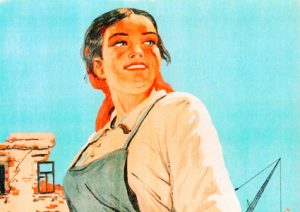This article was first published in the September 2016 issue of Standpoint.
Walking around the old Soviet factory in Narva, Estonia, recently, yards from the border with Russia, I saw her. Stuck on a pillar, Olga gazed out from an old propaganda poster. Grey and grainy, she typified hearty, hefty Soviet womanhood. She was built like the tractor she drove with one hand, harvesting the wheatfields of the motherland with a sickle or scythe in the other and singing patriotic songs. She had a broad face, no makeup and rosy cheeks, with a three-pointed kerchief holding her short hair in place while she furthered the cause of the revolution. Nothing could be further from any bourgeois ideal of beauty.
All was good for Olga until Nikita Khrushchev, who wanted to kick-start the Soviet fashion industry. In 1959 Yves Saint Laurent, then head of the house of Dior, travelled to the Soviet Union at Khrushchev’s invitation. YSL inspired one of the most powerful Soviet women, Yekaterina Furtseva, who was only the second woman to be admitted to the Politburo. She had immense influence over culture. “Furtseva approved Dior’s collection,” says Mariana Haseldine, an expert in Russian cultural history who grew up in Soviet times, “because Dior’s famous grey was suitable for Soviet working women and the lines were modest enough so they looked proper on decent women.”
Olga made a comeback in the Brezhnev era, but then came Mikhail Gorbachev and his wife Raisa with her Western style. The final blow came in 1991 when the Soviet edifice crumbled. Like a nightmare version of living matryoshka dolls, out popped a never-ending phalanx of supermodels, each more gorgeous than the last. Where the hell did these women come from? And whatever happened to Olga? I am quite sure she did not marry an oligarch.
This phenomenon has puzzled me for 25 years. John Lloyd, the Financial Times Moscow bureau chief from 1991 to 1995, has an explanation. “During the Soviet era, the internal propaganda was to emancipate women. The emphasis was on equality and the masculinisation of women. And, of course, there was little access to good makeup and decent clothes.” Yet most Soviet women were having none of this officially-imposed dowdiness. While no luxury industry existed, women set enormous store by looking beautiful. “The feminist revolution never happened in Russia,” continues Lloyd, “because if, for example, you came from a Siberian village all you wanted to do was get out. Men drank themselves to death by 40 and the rest were thugs. There were not many options and marrying well was one of them.”
Haseldine remembers her mother, a chemist, and her friends reading the German fashion magazine Burda and setting great store by dressing immaculately. Some would make their own clothes, while the wives of the powerful men of the Politburo had access to their own dressmakers. Soviet women listened to their grandmothers: they kept slim by avoiding potatoes and white bread, they exercised, and used beetroot to rouge their cheeks and lips. After all, there were few men left after the war.
In the Nobel Prize-winning journalist Svetlana Alexievich’s new book Second-Hand Time (Fitzcarraldo Editions, £14.99) she quotes the manager of a Russian advertising agency: “Women aren’t looking for their knight in shining armour to come galloping in on a white horse — they want him on a sack of gold. Money rules the world!” The oligarchs’ bimbos say as much about Putin’s Russia as the tractor-driving Olgas did about Stalin’s or Khrushchev’s. It’s time to Cossack-dance back into the giant matryoshka whence they came, which may have been from Russia but not with love.
Read this article online on Standpoint here.
Download this article as a PDF here.


